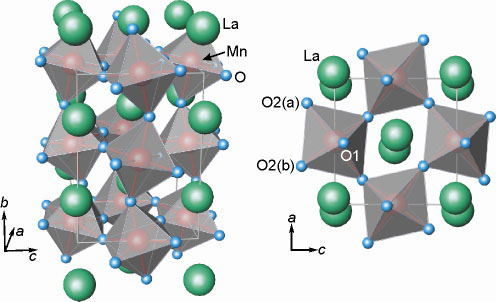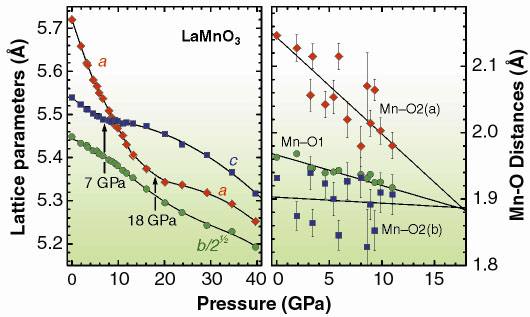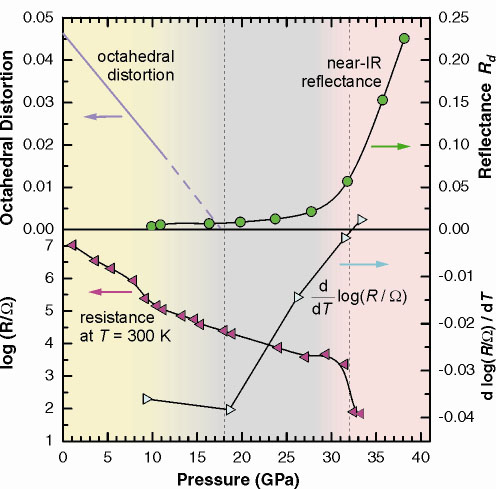- Home
- Users & Science
- Scientific Documentation
- ESRF Highlights
- ESRF Highlights 2001
- Materials
- Pressure-induced Quenching of the Jahn-Teller Distortion and Insulator-Metal Transition in LaMnO3
Pressure-induced Quenching of the Jahn-Teller Distortion and Insulator-Metal Transition in LaMnO3
Perovskite-type manganites have recently received renewed interest after the observation of a negative colossal magneto-resistance (CMR) effect in La1-xCaxMnO3 and related materials. Correlated magnetic and metal-insulator transitions are observed as a function of temperature, magnetic field, and doping along with charge and orbital ordering/disordering phenomena [1,2]. The complex electronic properties of both doped manganites and pure LaMnO3 originate from an intimate interplay of lattice and electronic degrees of freedom. At ambient conditions LaMnO3 is an insulator with an orthorhombic perovskite structure (space group Pnma, see Figure 121). Alternating long and short MnO2 distances in the ac plane of the structure are a sign of orbital ordering, which arises from a cooperative Jahn-Teller (JT) distortion.
 |
Fig. 121: Crystal structure of LaMnO3. |
High pressure is a means to tune the interplay between lattice and electronic degrees of freedom in LaMnO3. We have studied the effect of hydrostatic pressure to 40 GPa on its crystal structure by monochromatic ( = 45.09 pm) X-ray powder diffraction at the beamline ID9. These experiments were complemented by Raman spectroscopy, optical reflectivity, and electrical resistance measurements at high pressures.
Up to 1520 GPa, the compression of LaMnO3 is anisotropic with the soft direction along the a axis (Figure 122). Its initial compressibility is ~ 4 times larger than those of the b and c axes. LaMnO3 remains orthorhombic to at least 40 GPa.
 |
| Fig. 122: Lattice parameters and MnO distances in LaMnO3 as a function of pressure. |
Rietveld analysis of the powder diffraction data allows us to refine the full crystal structure up to 11 GPa. The three MnO distances of the distorted MnO6 octahedra decrease under pressure (Figure 122). This effect is most pronounced for the MnO2(a) distance which relates to the large a-axis compressibility at low pressures. Extrapolation of the data suggests that MnO bond lengths become nearly equal around 18 GPa. The cooperative Jahn-Teller effect is reduced with increasing pressure, a process that appears to be completed near 18 GPa.
A pressure-induced insulator-metal transition takes place at pressures much higher than required to suppress the Jahn-Teller effect. It occurs at ~ 32 GPa as evidenced by optical reflectivity and electrical resistance measurements (Figure 123).
 |
Fig. 123: Structural, electrical and optical properties indicate three distinct regimes/phases in LaMnO3: insulating with JT-distortion, insulating without JT-distortion, and metallic. |
Our results suggest the existence of three distinct regimes: (i) an insulating one with JT distortion and orbital ordering [P < 18 GPa], (ii) an intermediate one with suppressed JT distortion and no orbital ordering, but still insulating [1832 GPa], and (iii) a metallic phase without JT effect [P > 32 GPa]. For a certain range of pressures, undoped LaMnO3 thus appears to exist in an insulating state, which is not caused by the JT effect. This supports the view that LaMnO3 basically is a Mott (or charge-transfer) insulator.
The pressure-induced decreases of the MnO distances and of the octahedral tilting both enhance the Mn-O-Mn interactions and hence enlarge the bandwidth arising from the eg orbitals. In the intermediate insulating state the eg electrons are already sufficiently delocalised to suppress the JT effect, but still not itinerant enough to make the system metallic. It cannot be excluded from our data that the stabilisation of this insulating state involves other instabilities, e.g. a charge-density wave formation similar to that observed in the isoelectronic (t32ge1g) Fe4+ oxide CaFeO3. In contrast to the CMR materials, the insulator-metal transition in LaMnO3 is driven by an increased bandwidth and not by chemical doping.
The notion of delocalisation of eg (or t2g) electrons without metallisation seems also of relevance for other transition metal oxides with Jahn-Teller electron configurations, e.g. Fe4+ oxides, rare earth nickelates, and LaTiO3. At ambient pressure many of these materials are close to the insulator-metal borderline and some reveal insulating states without signs of orbital ordering.
References
[1] A.P. Ramirez, J. Phys.: Cond. Matter 9, 8171 (1997).
[2] J.M.D. Coey, M. Viret, and S. von Molnár, Adv. Phys. 48, 167 (1999).
Publication
I. Loa (a), P. Adler (a), A. Grzechnik (a), K. Syassen (a), U. Schwarz (b), M. Hanfland (c), G.Kh. Rozenberg (d), P. Gorodetsky (d) and M.P. Pasternak (d), Phys. Rev. Lett. 87, 125501 (2001).
(a) MPI für Festkörperforschung, Stuttgart (Germany)
(b) MPI für Chemische Physik fester Stoffe, Dresden (Germany)
(c) ESRF
(d) Tel Aviv University (Israel)



